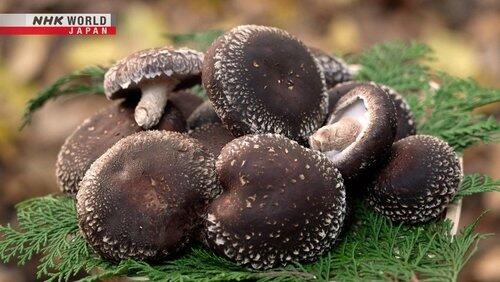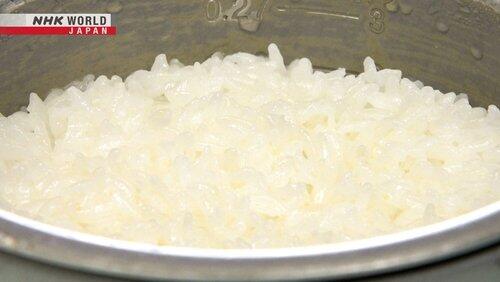Trails to Oishii Tokyo - Season 6 / Year 2023

Season 6 / Year 2023

Episodes

SHIITAKE
Shiitake — the star Japanese mushroom known for its strong umami. Visit a farmer who uses centuries-old cultivation methods to conserve the natural surroundings, then head over to our reporter's hometown in Sweden to see how shiitake have grown in popularity overseas. We'll be cooking up all kinds of mushroom dishes, from Scandinavian to French to Japanese. (Reporter: Janni Olsson)

SERI
Seri, in season from winter to spring, was a key source of nutrition during harsh winters when produce was scarce. It grows in cold, mineral-rich water, giving it a delectable crunch and aroma. Join our reporter in muddy, flooded paddies for a harvest experience and check out a local dish that took on an iconic role in post-earthquake recovery. Also visit TOKYO SKYTREE for seri Italian dishes that are truly inspired. (Reporter: Kyle Card)

WASANBON
In Japan, there's a type of sugar for nearly any recipe. Among them, wasanbon is perhaps the most precious, as it's produced in only six refineries in the country's Shikoku region. The secret to its quality lies in a traditional method practiced since the Edo period. See the magic happen for yourself, and feast your eyes on all kinds of food that call for Japan's special sugar. (Reporter: Kailene Falls)

Japanese Rice Goes Global
Going beyond sushi, Japanese food of all kinds is loved across the globe, and its core ingredient, rice, is steadily taking the world by storm. Ever had onigiri in Paris? Try high-end ones made with Japanese rice or localized versions that use French ingredients. Also learn about rice flour's role across Europe as a gluten-free ingredient and a type of Japanese rice grown specifically for the international market. (Reporter: Kyle Card)

SOMEN
Somen: these traditional Japanese noodles are amazingly thin and white. Japan has many noodles, like soba, udon and ramen, but the saga of somen goes back some 1,200 years. We visit Miwa, Nara Prefecture to see how traditional techniques are used to stretch somen again and again over a two-day period to achieve millimeter thinness. We also see how somen works in recipes from curry to Okinawan to even Italian with cheese and tomato sauce. Slurp into the history of somen! (Reporter: Saskia Thoelen)

KUZU
Kuzu plays a key role in Japanese cuisine, from savory to sweet. The starch can be mixed in hot water to form a clear jelly, or used to thicken sauces and soups. The raw material is found deep in the mountains. Our journey takes us from harvest to factory, detailing a long process that remains largely unchanged for over 200 years. Feast your eyes on exquisite food featuring kuzu, an unsung hero of Japan's culinary culture. (Reporter: Alexander W. Hunter)

YOMOGI
Yomogi speckles the fields and roadside greenery of the spring season. Used in various dishes, from savory to sweet, the plant is also used to produce a substance called moxa for healing methods that date back over 1,000 years. The "queen of the herbs" is even mentioned in classical poetry. With health benefits thought to promote longevity, it's played a key role in Okinawan tradition. Dig in to discover more about this overlooked weed!
(Reporter: GOW)

HIMONO
Himono, or dried fish, is a product of Japan's long history as an island nation blessed with seafood. Armed with wisdom from the past, preservation methods have evolved to enhance flavor. How does it get so juicy and packed with umami? Visit a key production area to see artisans at work, and feast your eyes on himono dishes that are reinventing the wheel. (Reporter: Alexander W. Hunter)

YUBA
Yuba is the thin film that forms when soymilk is heated. It's rich in protein and nutrients and is essential in Buddhist cuisine. We visit temple-filled Kyoto, where yuba has long been a prized ingredient used in everything from high-end cuisine to home cooking. We visit a yuba producer founded over 300 years ago to discover how it's made, and enjoy yuba dishes at a world heritage temple and traditional Kyoto restaurants. In Tokyo, we see how yuba can be used in even French cuisine. (Reporter: Kailene Falls)

HOYA
The hoya, or sea pineapple, is one of the ocean's hidden delicacies. Protected by a hard shell, the marine animal's meat offers a wide range of flavors, including rich umami. In Miyagi Prefecture, hoya aquaculture has come a long way since the devastating tsunami that followed the Great East Japan Earthquake of 2011. Feast your eyes on an array of dishes featuring the edible ascidian, and discover how a restaurant in Tokyo is breathing new life into French cuisine. (Reporter: Janni Olsson)

BUTTER
Butter in Japan is typically unfermented. This allows the characteristics of the raw milk it's produced from to shine through—but milk's flavor varies by climate. In Hokkaido Prefecture, Japan's largest production area for butter, watch cows produce milk in a stress-free environment and visit a large butter processing factory. Then, feast your eyes on a number of savory recipes, including inspiring ways to incorporate butter into traditional Japanese cuisine. (Reporter: Michael Keida)

JAPANESE MUSTARD
Japanese mustard, or karashi, is an essential condiment for tonkatsu pork cutlets, the stewed dish known as oden, and many other everyday meals. We visit a mountain village in Kyoto Prefecture and meet a family who farms their own mustard greens to make karashi. This time-consuming process involves harvesting and filtering tiny seeds then grinding them into powder with an old-fashioned millstone! We also try a variety of delicious karashi dishes on this fun and spicy episode. (Reporter: Kailene Falls)

Japan's Fermented Foods Go Global
More than just a longer shelf life, Japan's fermented foods offer enhanced flavor and nutrition. Unlock secrets to the culture's longevity, starting with koji mold cultivation that dates back 600 years. Get an inside look at how the foods are taking the world by storm as we join a miso workshop in Paris and view the largest sake brewery in the U.S. Introducing Japanese fermentation—the foundation of the island nation's renowned cuisine. (Reporter: Michael Keida)

JAPANESE CURRY
Curry in Japan mainly comes as a thick sauce poured over white rice. With the development of roux cubes, curry rice became easy to make at home and in schools, launching the food into national stardom. Specialty shops across the country also began cooking up their own versions of the popular dish. Once ready-to-eat pouched food hit the market, Japanese curry became a tasty regional souvenir. Discover more about the unique world of Japanese curry! (Reporter: Jason Hancock)

FUKUSHIMA: FRUIT KINGDOM
Fukushima Prefecture has two mountain ranges and three differing climates, allowing a variety of fruits to grow. Areas facing the ocean have cool summers and warm winters—perfect for pears. In a basin sandwiched between eastern and western mountain ranges, daily temperature fluctuations produce large, sugar-packed peaches. Furthermore, inland areas with heavy snowfall offer some of the finest persimmons. Discover the charms of Japan's fruit kingdom—Fukushima. (Reporter: Michael Keida)

WAGASHI
Wagashi, or traditional Japanese sweets made with unique ingredients like bean paste and agar jelly, are little works of art that excite all five senses. Their beauty and flavors reflect the changing of the seasons. Join us in Japan's former capital, Kyoto, to discover how wagashi became ingrained in daily life. At a shop that prepares desserts for tea parties, learn to make Japanese sweets using bean paste and traditional tools. Also explore the food's place in modern society, including coffee pairing and the use of novel ingredients that transform wagashi into a full-course meal. (Reporter: Michael Keida)

NODOGURO
Nodoguro, characterized by red scales and large eyes, is a fatty, umami-packed fish. Starting out on regional dinner tables, it achieved national fame along with the development of the internet and shipping technology. Its flavor had a lot to do with its success, as demand eventually bumped nodoguro up to high-end prices! Visit Hamada Fishing Port in Shimane Prefecture to learn nodoguro's importance on local industry, and feast your eyes on juicy dishes at Japanese and French restaurants in Tokyo. (Reporter: Saskia Thoelen)

JAPANESE GIN
Gin, the popular fragrant spirit made from juniper berries, is experiencing a global "craft" boom. Expert distilleries are popping up across Japan as well. In central Tokyo, taste botanical gin that pays homage to regional history. In Gifu Prefecture, quality water and lush seasonal crops make excellent gin. Also learn about a distillery that uses recycled cacao and beer products. This and more about Japan's cool gin scene. (Reporter: Kyle Card)

SAITAMA WHEAT
Saitama Prefecture, next to Tokyo, is known for its wheat cultivation and as an udon noodle kingdom. We explore Saitama's wheat culture by visiting flour mills and farmers and trying local udon and even beer. (Reporter: Janni Olsson)

APPLES
Nagano Prefecture in central Japan gets long sunlight hours and large temperature drops between day and night. This makes for some tasty apples! Feast your eyes on unique sweets made from native varieties! (Reporter: GOW)

GOBO
Japan is likely the only country to have incorporated gobo, a root vegetable, into its diet on such a wide scale. Witness novel and traditional harvesting methods and feast your eyes on unique dishes.
Recently Updated Shows

Resident Alien
Resident Alien is a dark, twisted and comedic fish-out-of-water story that follows a crash-landed alien named Harry who, after taking on the identity of a small-town Colorado doctor, slowly begins to wrestle with the moral dilemma of his secret mission on Earth — ultimately asking the question, "Are human beings worth saving?"

Interview with the Vampire
Based on Anne Rice's iconic and bestselling novel, Interview with the Vampire follows Louis de Pointe, Lestat de Lioncourt and Claudia's epic story of love, blood and the perils of immortality, as told to the journalist Daniel Molloy. Chafing at the limitations of life as a Black man in New Orleans in the early 1900s, Louis finds it impossible to resist the rakish Lestat de Lioncourt's offer of the ultimate escape: joining him as his vampire companion. But Louis's intoxicating new powers come with a violent price, and the introduction of Lestat's newest fledgling, the child vampire Claudia, soon sets them on a decades-long path of revenge and atonement.

The Paper
The Paper finds the same documentary crew that immortalized Dunder Mifflin Scranton searching for a new subject. They ultimately find it in an historic Toledo newspaper, The Truth Teller, and the eager publisher that's trying to revive it.

Gordon Ramsay's Secret Service
Restaurateurs who are looking for a quick fix or social media glow-up are in for the surprise of their lives when famed culinary titan Gordon Ramsay trades his signature chef knives for a state-of-the-art surveillance vehicle and cutting-edge spyware in FOX's all-new unscripted series, Gordon Ramsay's Secret Service. In a Gordon Ramsay series first, Chef Ramsay will venture into struggling restaurants under the cover of night. With the help of a secret source on the inside, he'll gather raw, unfiltered evidence and get a 360-degree view of the major issues facing each restaurant. This insider will not only remain a secret to the staff, but will also help Ramsay infiltrate the restaurant after-hours for a dramatic nighttime black light kitchen investigation that reveals more filth and grossness than ever before. By the time Ramsay reveals his identity, it will be too late for staff to cover up their culinary crimes. Gordon Ramsay's Secret Service will be his toughest assignment yet as he takes drastic measures to transform not only the restaurant but also the staff, because Gordon knows he can upgrade the menu and renovate the restaurant, but the most important change has to come from the people. Are the restaurant and staff willing to accept Gordon's mission, or are they too far gone to be saved?

MasterChef
Three celebrated food experts put the latest group of contestants through a series of challenging elimination rounds and turn one home cook into a culinary master.